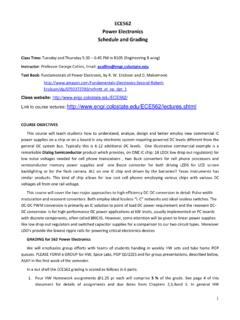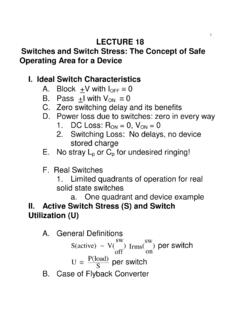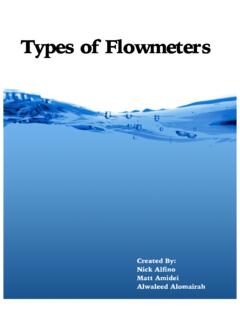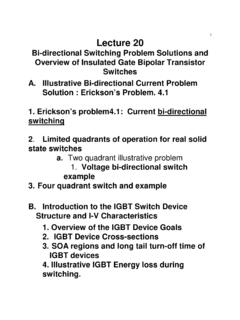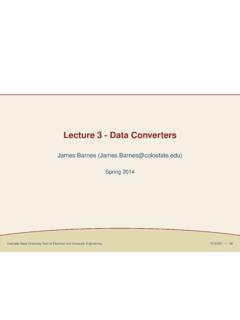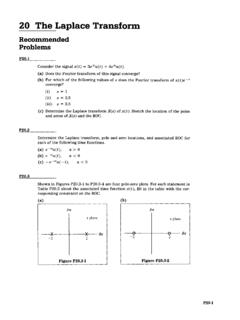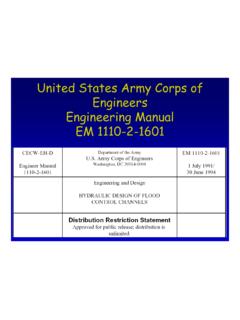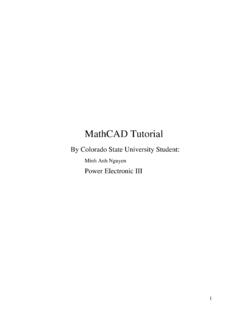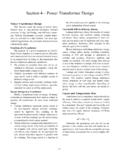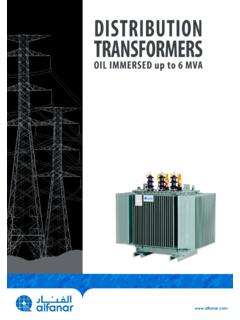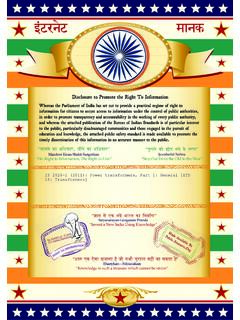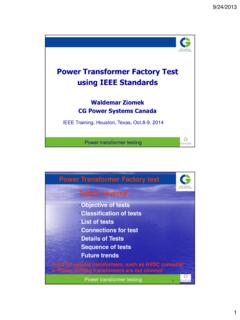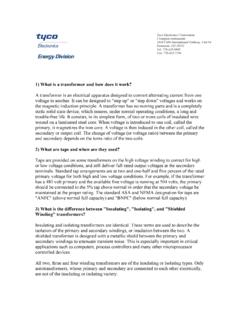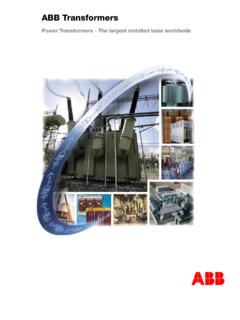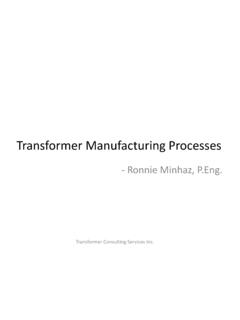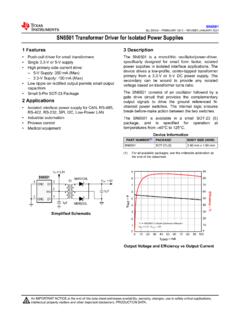Transcription of LECTURE 34 HIGH FREQUENCY TRANSFORMER - Walter …
1 1 LECTURE 34 HIGH FREQUENCY of Cu Wire Windings and Core WireWinding Wire Skin Effect and Multi-wireProximity Effects Alter Both Primary andSecondary R(wire coil) via Effective Acu (wire) Inductance s: Lm and Lla. Magnetizing Inductance, Lm: Core Fluxb. Leakage inductance, Ll: Air Window FluxA crude estimate for Ll is (1*Lm)/ andInterleaved Primary/Secondary Windingeffects Core Loss: Rma. Hysteresis Loss due to frictional movementb. Eddy Current Loss due to core is the TRANSFORMER Magnetization Current,im ,Created?a. im is Not effected by load current at allb.
2 Im = vLdt/Lm volt-second driven (max) of the core of a LossyTransformera. Heat Balance EquationT(core) = T(ambient) + P(core and wireloss)*R(core and winding Structure) Inductors vs Case for Wire Losses in Transformerswith Multiple Windings ~ Number of Wire Turns, I ~ Depends onLoad Impedance in the winding Area for the k th coil K = of PWM ConverterAK ( winding ) = f(PK,D), that is the winding arearequired depends on the duty cycle employed in theelectrical circuit. Generally, this is a range of 34 High FREQUENCY TRANSFORMERSIn part A we will focus on transformers and the relation betweenmagnetic and electrical properties.
3 We then use the information gleanedfrom relating the copper wire turns loss of a TRANSFORMER to moreaccurately treat the case of an inductor which carries only AC currents inpart B. Previously we treated only the filter inductor, which had smallAC currents. For HW #1 do problems 1 and 5 of Chapter 14 fromErickson s text and the questions we have raised in the LECTURE notesto date. THIS IS DUE NEXT BasicsTwo or more wire windings placed around a common magnetic core isthe physical structure of a TRANSFORMER . It s electrical purpose is totransfer power from the primary winding to the other windings with noenergy storage or HW# 1 show the B-H curve for a TRANSFORMER with transferredand core loss energy choice of circuit topology obviously has great impact on thetransformer design.
4 Flyback TRANSFORMER circuits are used primarily atpower levels in the range of 0 to 150 Watts, Forward converters in therange of 50 to 500 Watts, half-bridge from 100 to l000 Watts, and fullbridge usually over 500 Watts. The waveform and FREQUENCY of currentsin transformers employed in these unique circuit topologies are allunique. Intuitively we expect all windings employed on a giventransformer to take up a volume consistent with their expected powerdissipation. What is not intuitively clear is that there is an optimumcore flux density, BOPT , where the total of copper and core losseswill be a minimum.
5 This BOPT will guide TRANSFORMER and AC inductordesign. For if we hit the BOPT target we will operate with minimumtransformer losses and achieve minimum temperature of the of Copper Windings and Core Wire Winding4 Windowa. OverviewLets for simplicity consider only two wire windings wound upon onemagnetic core, which acts to couple the magnetic flux between the twocoils with near unity transfer. The main purpose of a power transformerin Switch Mode power Supplies is to transfer power efficiently andinstantaneously from an external electrical source to external loadsplaced on the output windings.
6 In doing so, the TRANSFORMER alsoprovides important additional capabilities: The primary to secondary turns ratio can be established to efficientlyaccommodate widely different input/output voltage levels. Multiple secondaries with different numbers of turns can be used toachieve multiple outputs at different voltage levels and differentpolarities. Separate primary and secondary windings facilitate high voltageinput/output isolation, especially important for safety. A set of k wire windings introduces some complexity to the issues foran optimum TRANSFORMER winding partitionFor the case of multiple windings the competing issues are morecomplex as we will see at the end of this LECTURE .
7 It will requireLagrangian optimum analysis using one variable for each wire coil. Inthe end the winding area allotted to each coil winding will vary as itspower handling requirement compared to the total power the wire windings, wound on a given core must fit into its one wirewinding window which we term either AW or WA in the text symbols are found in the TRANSFORMER literature. Much of the actualwinding area is taken up by voids between round wires, by wireinsulation and any bobbin structure on which the wire turns are mountedas well as insulation between high voltage and low voltage windings.
8 Inpractice, only about 50% of the window area can actually carry activeconductor, This fraction is called the fill factor. In a two-windingtransformer, this means that each winding can fill not more than 25% ofthe total wire winding window areaTotal area for windings Aw=Apri+AsecAw is split into two parts, for a two winding TRANSFORMER , according tothe required wire sizes (AWG#) in each coil which in turn is chosen forthe expected current flow to avoid overheating of the wires. In short theprimary wire winding area employed in the wire winding window is:wpricu wirecuA(prim) = NA (AWG # of primary)K(primary)Note that we use AWG tables for USA wires specified in cir mils.
9 EUCtables for wires are specified in KCu is an estimate of what % of the wire volume is actuallyCu. Kcu is specified for each type of wire and spans a range: Kcu(Litz6wire) = and Kcu(Cu foil) = This is nearly a factor of 3possible variation. The same is true for the secondary wire wirecuA(sec) = NA (secondary WG #)K(secondary)AWith different wire type choices for the primary and secondaryKcu(primary) Kcu(secondary). If we want heat from I2R or J2 lossesto be uniformly distributed over core window volume, then we usuallychoose the same type wire for primary & secondary windings to getsimilar Kcu ,but vary AWG # to achieve the same J in the two sets ofwindings.
10 That way both windings heat uniformly if cuJ2(primary) = cuJ2(secondary) 2primcuIA(primary) 2seccuIA(secondary) Area of Cu wire or AWG# must be different for primary vs secondarywires since Isec Ipri. So we find in a usual TRANSFORMER AWG#(primary) AWG #(secondary) and for no skin effects follow the rule:primseccucusecprimII = A(A() = NNprimarywire)secondarywireSince both wire windings must fit in the core wire window area Aw orWA we have a constraint: A(sec) A(prim) = )wirefor (windowA+wIn short, wire size is selected to support both the desired level of currentand to fit into the core's window area.
